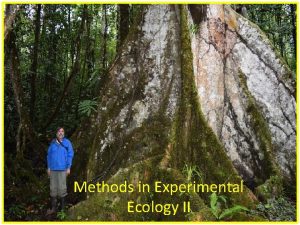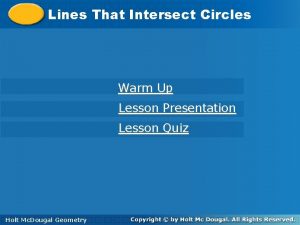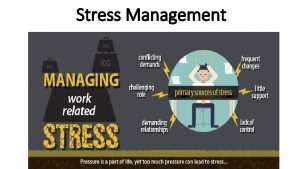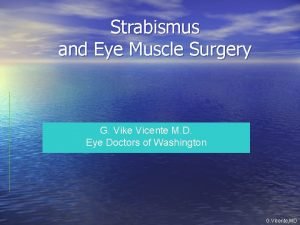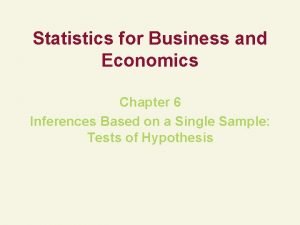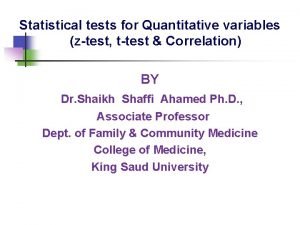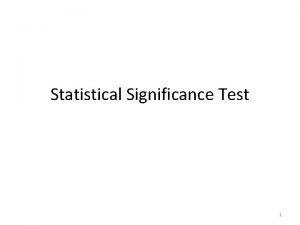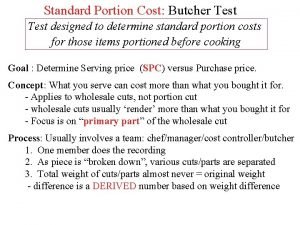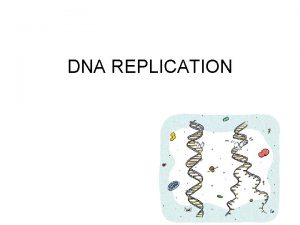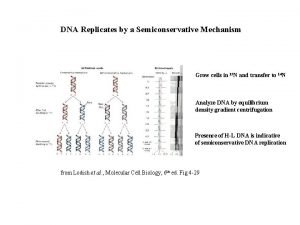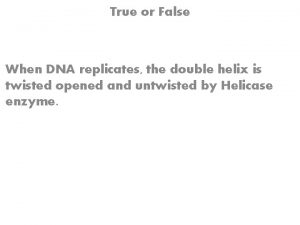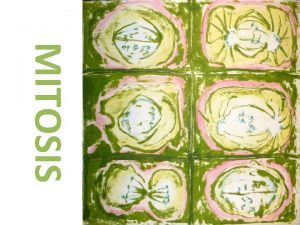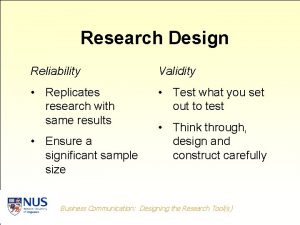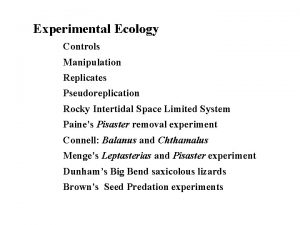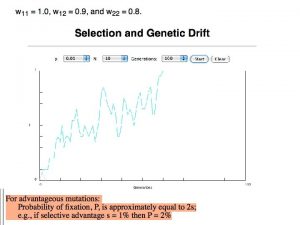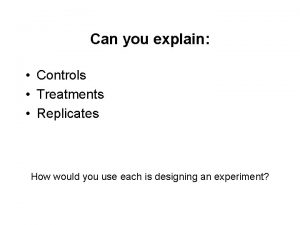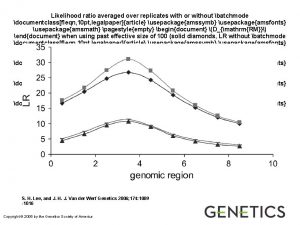DNA Test 1 3 When DNA replicates each




















- Slides: 20

DNA (Test 1) 3. When DNA replicates, each strand of the original DNA molecule is used as a template for the synthesis of a second, complementary strand. Which of the following figures most accurately illustrates enzyme-mediated synthesis of new DNA at a replication fork?

DNA (Test 1) 7. Lactose digestions in E. coli begins with its hydrolysis by the enzyme -galactosidase, lac. Z, is part of a coordinatley regulated operon containing the genes required for lactose utilization. Which of the following figures correctly depicts the interactions at the lac operon when lactose is NOT being utilized? (The legend defines the shapes illustrated)

DNA(Test 1) 19. The first diagram below shows the levels of m. RNA from two different genes (bicoid and caudal) at different positions along the anterior-positerior axis of a Drosophila (fruit fly) egg immediately before fertilization. The second diagram shows the levels of the two correspon ding proteins along the anterior—posterior axis shortly after fertilization.

Which of the following conclusions is best supported by the data? a. Bicoid protein inhibits translation of caudal m. RNA. b. Bicoid protein stabilizes caudal m. RNA. c. Translation of bicoid m. RNA produces caudal protein. d. Caudal protein stimulates development of anterior structures.

DNA(Test 1) 20. Sickle-cell anemia results from a point mutation in the HBB gene. The mutation results in the replacement of an amino acid that has a hydrophilic R-group with an amino acid that has a hydrophobic R-group on the exterior of the hemoglobin protein. Such a mutation would most likely result in altered: a. properties of the molecule as a result of abnormal interactions between adjacent hemoglobin molecules. b. DNA structure as a result of abnormal hydrogen bonding between nitrogenous bases. c. Fatty acid structure as a result of changes in ionic interactions between adjacent fatty acid chains. d. Protein secondary structure as a result of abnormal hydrophobic interactions between R-groups in the backbone of the protein.

DNA(Test 1) 24 -28 In a transformation experiment, a sample of E. coli bacteria was mixed with a plasmid containing the gene for resistance to the antibiotic ampicillin (amp). Plasmid was not added to a second sample. Samples were plated on nutrient agar plates, some of which were supplemented with the antibiotic amp. The results of E. coli growth are summarized below. The shaded area represents extensive growth of bacteria; dots represent individual colonies.

24. Plates that have only amp-resistant bacteria growing include which of the following? a. I only b. III only c. IV only d. I and II 25. Which of the following best explains why there is no growth on plate II? a. The initial E. coli culture was not amp resistant. b. The transformation procedure killed the bacteria. c. Nutrient agar inhibits E. coli growth. d. The bacteria on the plate were transformed.

26. Plates I and II were included in the experimental design in order to a. demonstrate that E. coli cultures were viable b. demonstrate that the plasmid can lose its amp gene c. demonstrate that the plasmid is needed for E. coli growth d. prepare the E. coli for transformation 27. Which of the following statements best explains why there are fewer colonies on plate IV than on plate III? a. Plate IV is the positive control. b. Not all E. coli cells are successfully transformed. c. The bacteria on plate III did not mutate. d. The plasmid inhibits E. coli growth.

28. In a second experiment, the plasmid contained the gene for human insulin as well as the amp gene. Which of the following plates would have the highest percentage of bacteria that are expected to produce insulin? a. I only b. III only c. IV only d. I and III

DNA (Test 1)

38. Based on your understanding of the ways in which signal transmission mediates cell function, which of the following predictions is most consistent with the information provided? a. In an environment with low fixed nitrogen, treating the Anabaena cells with a Ca-binding compound should prevent heterocyst differentiation. b. A strain that overexpresses the pat. S gene should develop many more heterocysts in a low fixed nitrogen environment. c. In an environment with abundant fixed nitrogen, free Ca levels should be high in all cells so that no heterocysts develop. d. In environments with abundant fixed nitrogen, loss of the het. R gene should induce heterocyst development

DNA (Test 1) 39. The following figure shows several steps in the process of bacteriophage transduction in bacteria. Which of the following explains how genetic variation in a population of bacteria results from this process? a. Bacterial proteins transferred from the donor bacterium by the phage to the recipient bacterium recombine with genes on the recipient’s chromosome. b. The recipient bacterium incorporates the transduced genetic material coding for phage proteins into its chromosome and synthesizes the corresponding proteins. c. The phage infection of the recipient bacterium and the introduction of DNA carried by the phage cause increased random point mutations of the bacterial chromosome. d. DNA of the recipient bacterial chromosome undergoes recombination

DNA (Test 2) 5. Which of the following correctly matches the class of RNA with its function? a. m. RNA transfers a message from DNA in the nucleus to the t. RNA in the cytoplasm. b. t. RNA transfers a message m. RNA in the nucleus to the r. RNA in the cytoplasm. c. m. RNA transfers a message from DNA in the nucleus to the ribosomes in the cytoplasm. d. t. RNA transfers a message from r. RNA in the nucleus to m. RNA in the cytoplasm.

DNA (Test 2) 7. During which scenario can a viral infection introduce genetic variation into the host? a. The combination of human flu virus & bird flu virus to create the H 5 N 1 subtype of flu virus b. Integration of viral DNA into bacterial DNA during the lysogenic cycle c. Maturation and assembly of viral components during the lytic cycle d. Bacterial infections in humans such as botulism, tetanus, and leprosy

DNA (Test 2) 19. Bacteria live in an environment that is ever changing. In order to be efficient there is no need to produce all of the same enzymes and proteins all of the time. One way to control the production of enzymes and other proteins is to a. use a posttranscriptional control such as a delay of the m. RNA exiting the nucleus. b. use internal cues to trigger gene regulation by proteins that bind to their DNA. c. use a promoter gene to signal where transcription is to begin. d. use an active repressor to cleave and splice the DNA sequences removing unneeded portions.

DNA (Test 2) 46 - 50 Each cell in multicellular eukaryotes, including humans, has a copy of all genes; however, different genes are actively expressed in different cells. Muscle cells, for example, have a different set of genes that are turned on in the nucleus and a different set of proteins that are active in the cytoplasm than do nerve cells. Like prokaryotic cells, a variety of mechanisms regulate gene expression in eukaryotic cells. These mechanisms can be grouped under 5 primary levels of control; 3 of them pertain to the nucleus, and 2 pertain to the cytoplasm. In other words, control

DNA (Test 2) 46. Because their environment is constantly changing, bacteria do not need the same enzymes all of the time. As a way to regulate the expression of its genes a portion of the DNA codes for a repressor that binds to the operator and stops the production of m. RNA. This description is most accurate for a. a regulator gene b. a promoter c. an operator d. an active repressor

DNA(Test 2) 47. The most critical level of eukaryotic genetic controls is the control of transcription in the nucleus. Transcription is controlled by DNA binding proteins called a transcription factor. Which description most accurately describes the actions of a transcription factor? a. TF’s work during DNA unpacking, physically moving nucleosomes aside, exposing promoters so that transcription may begin. b. TF’s bind to the promoter of the DNA, and with the help of mediator proteins and transcription activators forms a hairpin loop with the enhancer on the DNA. This complex attracts and bind RNA pol so that transcription may begin. c. TF’s are active in the eukaryotic nucleus and control genetic expression by removing introns from pre-m. RNA prior to its exit from the nucleus. d. TF’s are active outside of the eukaryotic nucelus and control

DNA (Test 2) 48. E. coli prefers to break down glucose and has a way to ensure that the lactose operon is maximally turned on only when glucose is absent. A molecule called cyclic AMP (c. AMP) accumulates when glucose is absent. What is the effect of c. AMP as it binds to an active CAP and the CAP binding site on the DNA? a. c. AMP is an enzyme which promotes the breakdown of lactose into its constituent parts b. c. AMP acts as an inactive repressor, acting so that RNA polymerase cannot attach to the DNA c. The binding site of c. AMP to the DNA causes the DNA to bend exposing the promoter to RNA polymerase d. The binding of c. AMP to the DNA causes the DNA to form a hairpin loop, allowing transcription to begin.

DNA(Test 2) 49. There is a group of proteins that assist bacteria in the controls of genetic expression. These proteins bind to DNA near the structural genes, essentially stopping RNA polymerase from attaching to DNA, halting the production of m. RNA. Which protein is best described this way? a. enzymes b. RNA polymerase c. Lactose d. Active and inactive repressors
 Pseudo replicates
Pseudo replicates Chapter 20 viruses and prokaryotes
Chapter 20 viruses and prokaryotes Function of dna polymerase 3
Function of dna polymerase 3 Bioflix activity dna replication nucleotide pairing
Bioflix activity dna replication nucleotide pairing Coding dna and non coding dna
Coding dna and non coding dna What role does dna polymerase play in copying dna?
What role does dna polymerase play in copying dna? Chapter 11 dna and genes
Chapter 11 dna and genes 7-3 more multiplication properties of exponents
7-3 more multiplication properties of exponents Identify each line or segment that intersects each circle
Identify each line or segment that intersects each circle Advantages of criterion-referenced assessment
Advantages of criterion-referenced assessment Www.123 test.com/disc-personality-test/
Www.123 test.com/disc-personality-test/ Hirschburg test
Hirschburg test Alternate prism cover test
Alternate prism cover test When to use z test and t test
When to use z test and t test Z test table
Z test table Univariate analysis tests
Univariate analysis tests Paired vs unpaired t test
Paired vs unpaired t test Butchery test is example of test to arrive at
Butchery test is example of test to arrive at When do we use z test or t test
When do we use z test or t test Nonparametric test
Nonparametric test Lancaster red-green test
Lancaster red-green test
